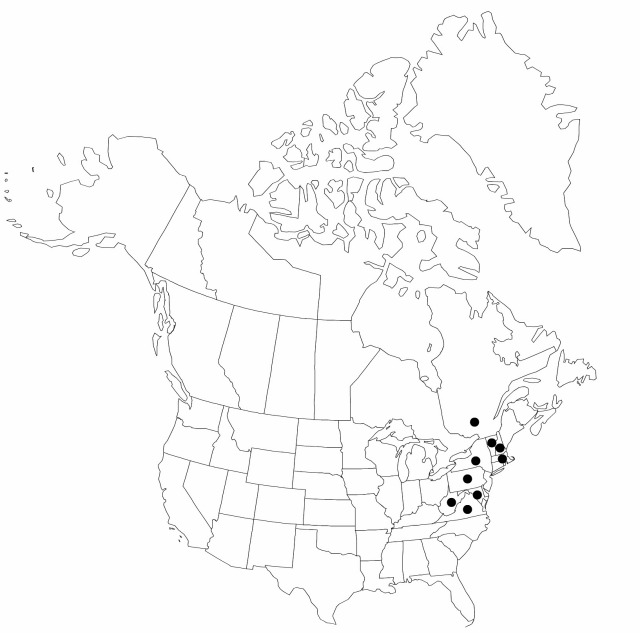Difference between revisions of "Scirpus ancistrochaetus"
Rhodora 64: 44, plate 1266, fig. 1. 1962.
FNA>Volume Importer |
imported>Volume Importer |
||
| (6 intermediate revisions by 2 users not shown) | |||
| Line 24: | Line 24: | ||
|elevation=100–1100 m | |elevation=100–1100 m | ||
|distribution=Que.;Md.;Mass.;N.H.;N.Y.;Pa.;Vt.;Va.;W.Va. | |distribution=Que.;Md.;Mass.;N.H.;N.Y.;Pa.;Vt.;Va.;W.Va. | ||
| − | |discussion=<p>Scirpus ancistrochaetus occasionally hybridizes with S. hattorianus. Scirpus ancistrochaetus once grew in Washington County, New York; it is apparently no longer present in the state.</p><!-- | + | |discussion=<p><i>Scirpus ancistrochaetus</i> occasionally hybridizes with <i>S. hattorianus</i>. <i>Scirpus ancistrochaetus</i> once grew in Washington County, New York; it is apparently no longer present in the state.</p><!-- |
| − | --><p>Scirpus ancistrochaetus is in the Center for Plant Conservation’s National Collection of Endangered Plants.</p> | + | --><p><i>Scirpus ancistrochaetus</i> is in the Center for Plant Conservation’s National Collection of Endangered Plants.</p> |
|tables= | |tables= | ||
|references= | |references= | ||
| Line 34: | Line 34: | ||
-->{{#Taxon: | -->{{#Taxon: | ||
name=Scirpus ancistrochaetus | name=Scirpus ancistrochaetus | ||
| − | |||
|authority=Schuyler | |authority=Schuyler | ||
|rank=species | |rank=species | ||
| Line 49: | Line 48: | ||
|publication year=1962 | |publication year=1962 | ||
|special status= | |special status= | ||
| − | |source xml=https:// | + | |source xml=https://bitbucket.org/aafc-mbb/fna-data-curation/src/2e0870ddd59836b60bcf96646a41e87ea5a5943a/coarse_grained_fna_xml/V23/V23_11.xml |
|genus=Scirpus | |genus=Scirpus | ||
|species=Scirpus ancistrochaetus | |species=Scirpus ancistrochaetus | ||
Latest revision as of 20:38, 5 November 2020
Plants cespitose; rhizomes brownish, short, tough, fibrous. Culms: fertile ones upright or reclining; nodes sometimes with axillary bulblets. Leaves 5–9 per culm; sheaths of proximal leaves green to whitish or brown; proximal sheaths and blades with septa many, conspicuous; blades 32–68 cm × 7–13(–16) mm. Inflorescences terminal, rarely also with 1 lateral inflorescence from distal leaf axil; rays all arching or sometimes 1 or 2 ascending, distal branches scabrous, proximal branches smooth, rarely scabrellous, rays sometimes with axillary bulblets; bases of involucral bracts green, margins usually speckled with red-brown, not glutinous. Spikelets in clusters of 2–18 (largest cluster with 8 or more), spikelets sessile, ovoid to narrowly ovoid, 3–5 × 2–3 mm; scales brown or blackish brown with greenish midribs, elliptic, 1.5–2.5 mm, apex slightly mucronate, mucro 0.05–0.1(–0.2) mm. Flowers: perianth bristles persistent, 6, stout, straight or curved, slightly shorter to slightly longer than achene, with retrorse, thick-walled, sharp-pointed teeth densely arranged in distal 0.6–0.9, enclosed within scales; styles 3-fid. Achenes pale brown, elliptic to obovate in outline, plano-convex, 1.1–1.7 × 0.6–0.8 mm. 2n = 54.
Phenology: Fruiting late spring–early summer (Jul).
Habitat: Growing in wet depressions, bogs, sinkhole ponds, or adjacent to pools
Elevation: 100–1100 m
Distribution

Que., Md., Mass., N.H., N.Y., Pa., Vt., Va., W.Va.
Discussion
Scirpus ancistrochaetus occasionally hybridizes with S. hattorianus. Scirpus ancistrochaetus once grew in Washington County, New York; it is apparently no longer present in the state.
Scirpus ancistrochaetus is in the Center for Plant Conservation’s National Collection of Endangered Plants.
Selected References
None.
